Metal Gear Solid 3: Snake Eater Final Version Hands-On
We HALO-jump straight into a final build of Metal Gear Solid 3, and bring you firsthand impressions of how the game finally shaped up.
It was three years ago that Metal Gear Solid 2: Sons of Liberty blew the minds of thousands of fans eagerly awaiting the next installment in Konami and designer Hideo Kojima's tactical espionage action series. Tons of prerelease information alluding to the game's storyline created some very high and very specific expectations, but the game itself turned out to have a different agenda, and ended up being one of the biggest surprises--for better or worse--that fans had ever received from a video game. Cut to the present. The release of the next Metal Gear Solid is just days away, and we've finally had a chance to play it nonstop, from the very beginning, for hours on end. We're here to give you our early impressions of how the game finally turned out (the early portions of it, anyway), in light of its illustrious predecessors.
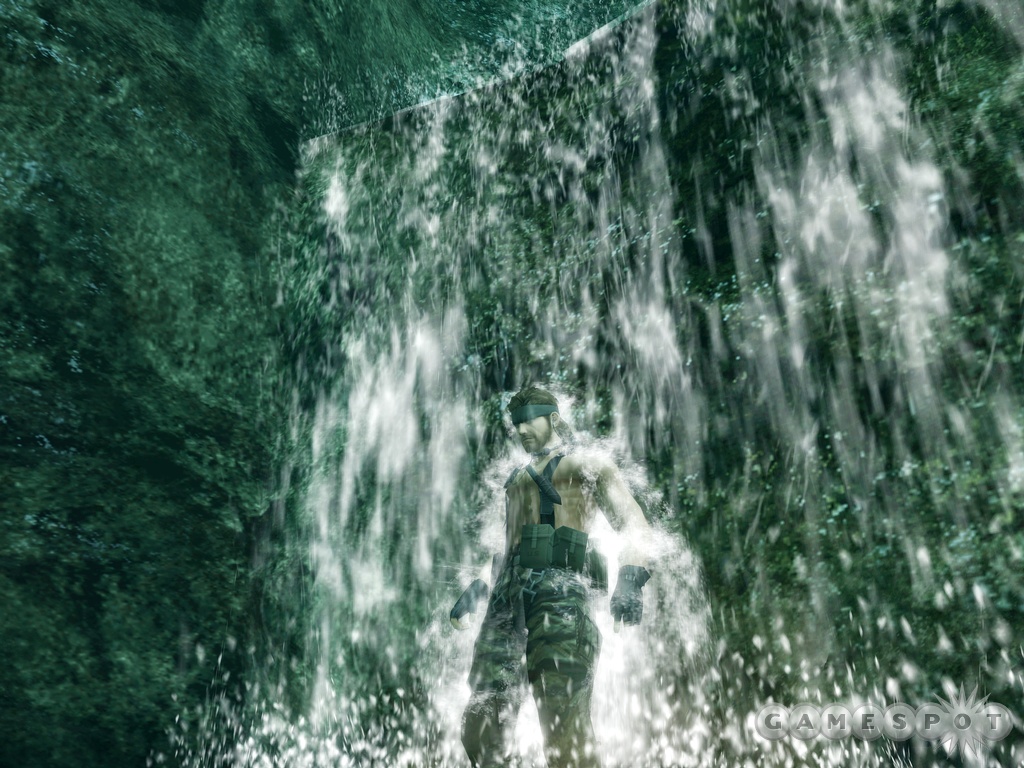
On page three, we'll be getting into specifics about the story and characters in the first several hours of the game. You may have already picked up on many of the presumed details from our previous coverage or from the numerous trailers highlighting the game's frequent noninteractive story sequences, but we'll actually help set the record straight here, without ruining any of the late-game surprises. However, if you want to experience all of Metal Gear Solid 3's shake-ups firsthand, then don't venture past the next page. For now, let's talk more generally about the gameplay.
To put it broadly, Metal Gear Solid 3 certainly feels like a sequel to MGS2 in virtually every sense. Granted, it's actually set up as a prequel, not a sequel. The game is set in the 1960s, during the Cold War. You should know that the tone and pacing of the game are consistent with those of MGS2, meaning that much of the game is purely noninteractive--you'll get to see plenty of beautifully choreographed action-movie-style cutscenes featuring the game's characters, and you'll also have to sit through plenty of expository dialogue in the form of MGS3's equivalent of the previous Metal Gear games' codec communications. These are mostly static affairs in which Snake, the game's main character, checks in with off-site contacts via radio. As for the gameplay itself, it's highly reminiscent of MGS2 for the most part, but it also features several new systems: camouflage, eating and stamina, survival medicine, and close-quarters combat.
These may sound like significant changes, but in practice none of them have impacted our playing experience a great deal. The camouflage system allows you to mix and match different uniforms and face-paint schemes to best fit the environment you're in. A percentage indicator clearly tells you which combinations of uniform and paint are optimal, and such things as keeping a low profile and moving slowly also help keep you concealed from enemy guards.
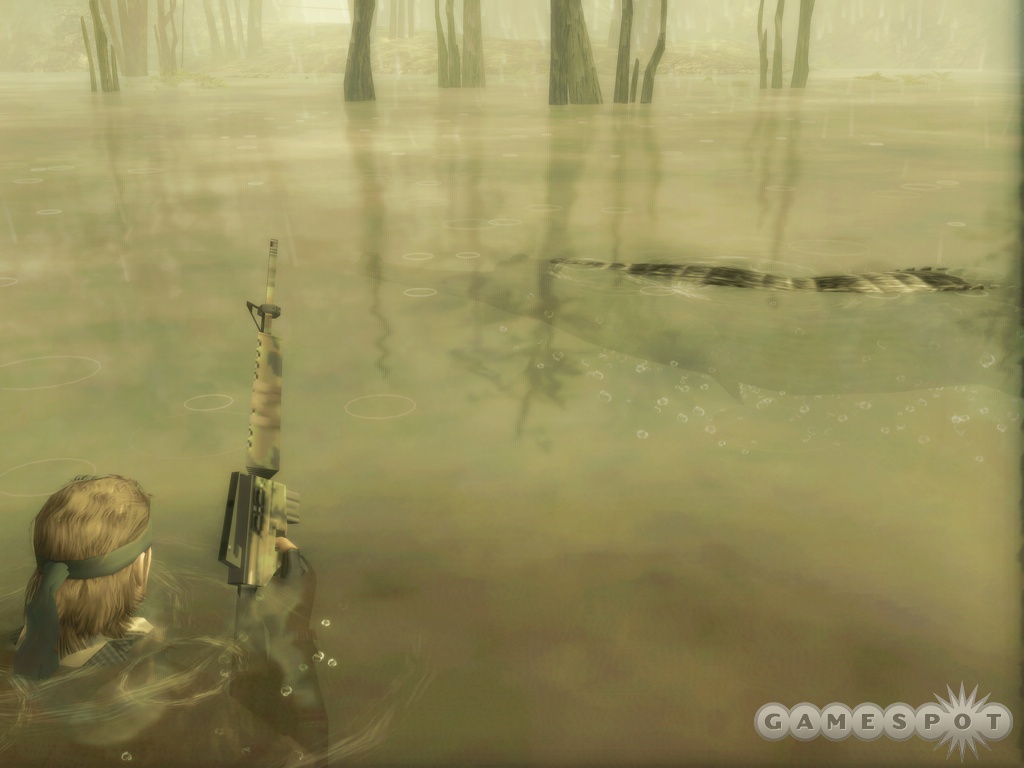
The new eating system helps give the impression that Snake is out there trying to survive alone in the woods, but it really isn't that big of a deal. Basically, you'll see lots of animals in the environment, and you can shoot or stab them and then save them for a snack (just be careful--dead animals will spoil, and spoiled meat will make you sick). For the most part, you won't automatically recover your health in MGS3. You will heal gradually, though, as long as you keep your stamina high, which you do by eating every now and then. You eat by simply selecting a hunted animal from a menu. It's all pretty abstract, and actually a little weird, since you can carry around a virtual zoo in your backpack. There are tons of different animals skulking about in MGS3, and for all you vegans out there, there's plenty of edible plant life as well. It's easy to keep Snake's stamina maxed out, but there are several consequences if you let it wear down, including slow healing, fading vision, and unsteady hands.
Snake can suffer some pretty heinous injuries this time around, too. Bone fractures, gunshot wounds, burns, even leeches--we'll talk about how he'll patch himself up from all this stuff next, and we'll also go into the enemy artificial intelligence and some other finer points of the game's technical features and presentation.
This Is a Sneaking Mission
As mentioned, Snake can incur some serious injuries in MGS3, which is where the survival-medicine system comes in. Basically, this is handled much like the hunting and eating--it's pretty abstract. Sometimes you'll see part of your life bar turn red. This indicates a serious injury, and to cure it--which you can do instantaneously and at any time--you hit the start button and go to the "cure" menu. There, you'll see your various gnarly injuries in X-rays of Snake. What you then do is "treat" each injury using a variety of different items in sequence. For example, if you've suffered a serious gunshot wound, you'll first use your knife to dig out the bullet, then disinfectant to clean the wound, then sutures to staunch the flow of blood, and then bandages to tidy things up. And then you'll be good as new.
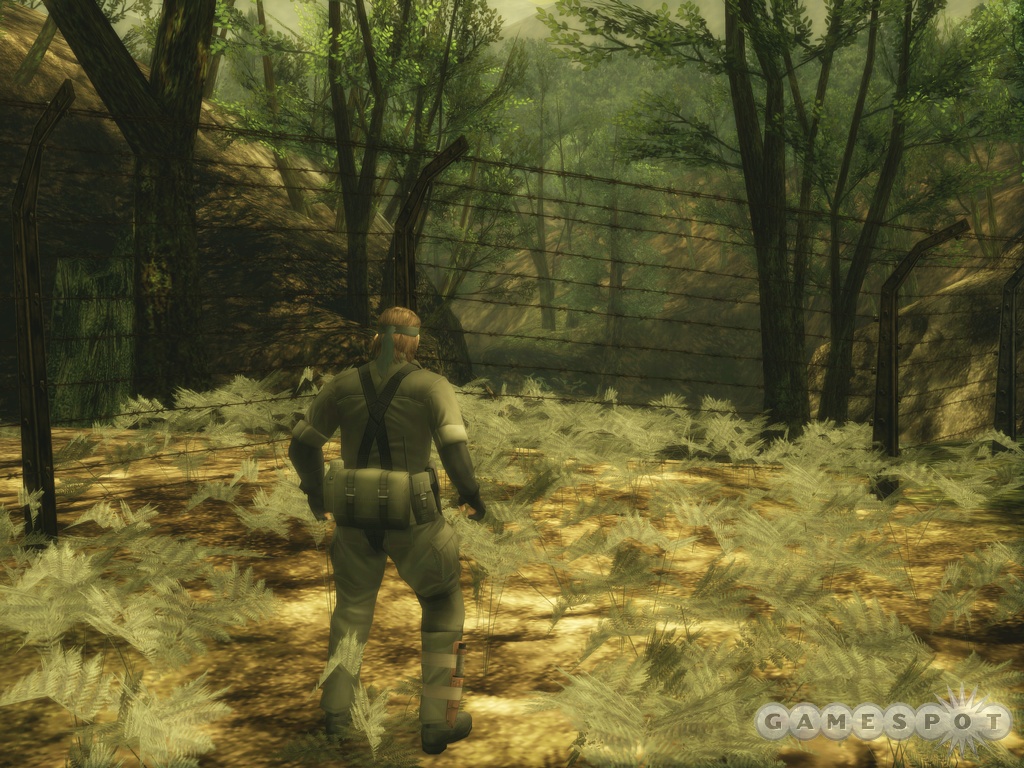
Snake's performance isn't really affected by what sound like some catastrophic injuries, and since he can recover from them in no time--even in the heat of battle--they just aren't that big of a factor. Still, they help establish the survivalist feel of MGS3. As does the presence of densely wooded environments filled with booby traps, quicksand, man-eating gators, and creepy caverns. Just great. This certainly is a far cry from MGS2's industrial corridors.
The game's close-quarters combat system mostly just seems like an extension of the grappling system that has been in the Metal Gear Solid series from the get-go. Once again, you can creep up behind and grab enemies, at which time you may slit their throats (Snake's historic aversion to bladed weapons is certainly not present in this prequel), use them as human shields, or even interrogate them. Snake's pretty good with a knife, which lets him easily take down weapon-wielding foes in straight-up combat, as long as he gets close enough.
The thing is, we haven't really employed the CQC system much, because, at the normal difficulty setting, there's little need to do so. First of all, outside of the boss fights, there just isn't that much pure action here. You're encouraged to slip past enemies, not kill them. Furthermore, your foes can now hear your footsteps (they were strangely deaf in previous MGS games), so it's a lot harder to get the drop on them now. Granted, you can use the D pad to move silently, but this is quite slow. Finally, there just isn't much of a penalty for being detected and taking a one-man army approach. Enemy gunfire does little damage to Snake, and his own firearms can instantly kill standard foes with a shot to the head. Since we've played MGS2, we had a much easier time getting reacquainted with the shooting here, rather than learning some of the nuances of the revised stealth system.
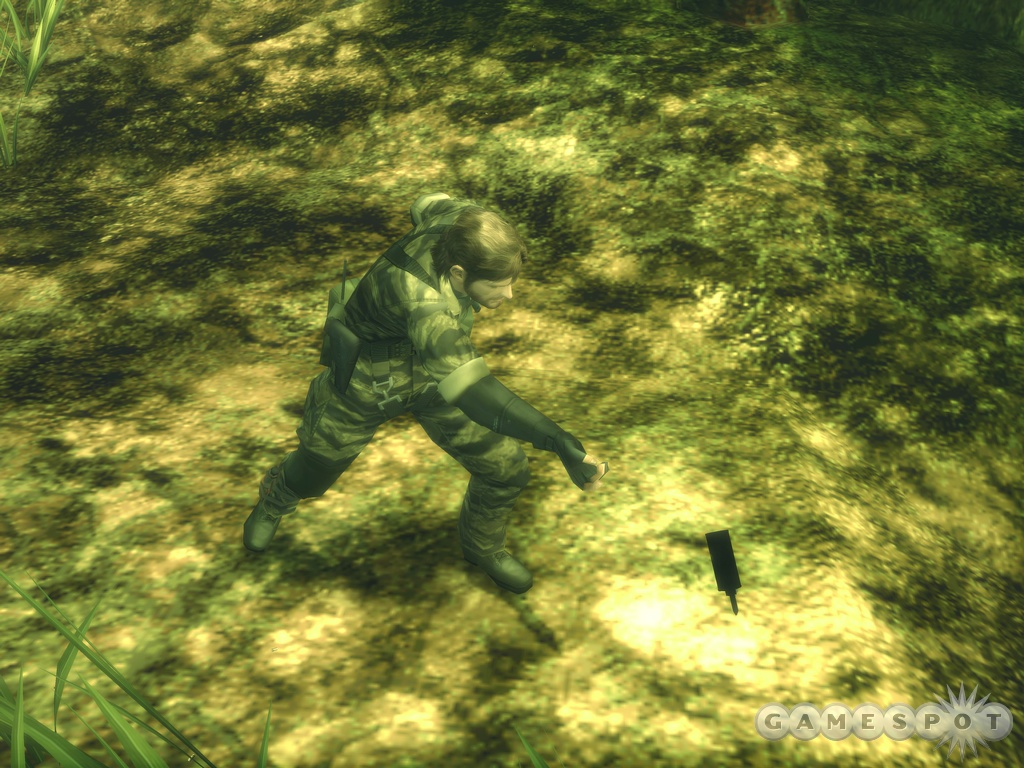
MGS3 controls a lot like MGS2, otherwise. The thing is, no other games out there have similar mechanics, so it actually took us a while to get a feel for the controls again, and the way in which it's necessary to frequently switch to a first-person view to look around. The game still plays from a third-person perspective, and the camera angles shift depending on the scene. You have a limited ability to control the camera, but we still found that it could be difficult to keep an eye on our enemies, especially since the MGS radar is nowhere to be found this time. Snake has some gadgets that can help pinpoint other life-forms in the vicinity, but they aren't nearly as precise as his old radar system. As a result, it's a lot tougher to stay hidden in MGS3 than in the previous games. Though, as mentioned above, it's also easier to kill all your assailants, should they find you. But you'll still need to run off and wait for the alarm to stand down to proceed past some mission-critical areas.
Again, though, probably the most important thing to point out about MGS3's gameplay is that it's not nearly as frequent as what you get from most games. Like its immediate predecessor, this is a deeply story-driven game, with tons and tons of dialogue that can come at you a mile a minute. We'll go over the early parts of the story next, both in general terms and in more-specific terms. Consider these minor spoilers--it's the setup for the plot, but none of the resolution.
"Kuwabara, Kuwabara"
First of all, we don't know what the hell "Kuwabara, Kuwabara" means at the moment, but it's one of the more-obscure things uttered by Metal Gear Solid 3's presumed villain, Colonel Volkin, the head of a paramilitary group called the Cobras (with all due respect to G.I. Joe fans, no doubt). Volkin is the heavily scarred man featured in the more-recent trailers for MGS3, and it's actually nice that he's clearly established as the bad guy fairly early on. One of the issues some fans had with MGS2's storyline was its failure to focus on a particular threat. Here, the threat is apparent. Snake is out to get Volkin, as well as Snake's former mentor, a woman known only as the Boss.
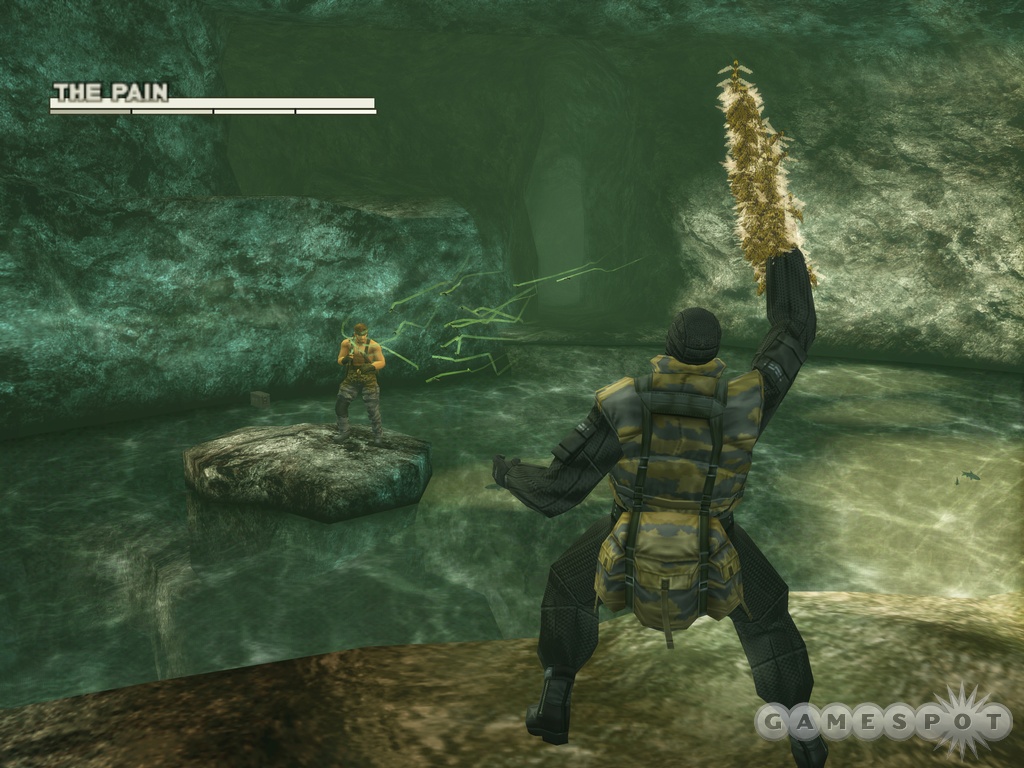
The plot delves deep into history and conspiracy theory. Volkin and the Boss are apparently in league with Leonid Brezhnev in an effort to oust then-Soviet premier Nikita Khrushchev from power. They seek to accomplish this by completing and then stealing a device called the Shagohod--a sort of precursor to the Metal Gear vehicles found in previous installments in the series. The Shagohod would tip the balance of power in the USSR in Brezhnev's favor, so Khrushchev implores President Lyndon Johnson--who owes Khrushchev a favor after Snake's botched operation at the beginning of the game--to send in his best to take care of business. That's where Snake comes in. The mission is to eliminate the Boss, Volkin, and the Shagohod and recover the Shagohod's inventor, a brilliant scientist named Sokolov. Of course, if you've played previous MGS games, then you know it won't be nearly this simple or straightforward.
For example, you'll run into the members of the Cobra squad, because every Metal Gear Solid game needs a pack of eccentric villains. These guys have names like the Pain, the Sorrow, the End, and the Fear. We've already faced off against the Pain, who certainly lives up to his name. He's able to summon swarms of savage hornets that can encase him in a shield that even bullets cannot penetrate, or sting even the hardiest of men to death.
We figured out how to take him down, though, using weapons like grenades, an AK-47, and an M16. The weaponry in MGS3 fits the '60s time period just fine, but it's honestly not so different from what you're probably used to from previous games in the series. Prior to giving the Pain the what for, we actually had a couple of run-ins with longtime Metal Gear Solid villain Revolver Ocelot, who's of course much younger here, and presented as the head of a powerful military squad. Ocelot is a talented but arrogant gunfighter, and in a nice sequence early on, Snake critiques his technique, suggesting that he might find even more success using a revolver instead of his current pistol. Sure enough, the impressionable Ocelot later returns with not one but two Colt Single Action Army pistols, and we actually got to fight him in a Wild West-style shootout. This is the game's first boss battle, in a throwback to the original Metal Gear Solid, but it plays out a lot like the fight against Olga in Metal Gear Solid 2.
Of course, Ocelot doesn't die here. In one of the stranger moments we experienced, we decided to put a bullet into Ocelot's unconscious head just to see what would happen. Sure enough, we got a "game over" screen, with what sounded like the voice of Metal Gear Solid's Colonel Campbell chastising us for creating "a time paradox." Yikes.

It must be said that Metal Gear Solid 3, much like its predecessor, is very, very strange. There's a lot of absurd, self-referential humor, such as one conversation between Snake and MGS3's token save-girl, who calls herself Para-Medic. She brings up Godzilla movies, mentions how the year 2004 will be Godzilla's 50th anniversary, and also points out how the original movie was "mostly mindless fun," but with a "serious anti-nuke message." Sound familiar? Besides that, we found the game's environments peppered with goofy, anachronistic paraphernalia, such as an issue of the Japanese hobbyist magazine Newtype, a whole bunch of these cute toy frogs, and--of course--plenty of Japanese pinup gals. Oh, and just wait'll you see what happens with a certain familiar-looking, slightly effeminate blonde-haired man at the beginning of the game.
This stuff, in addition to the over-the-top characterizations of the game's cast, certainly took us out of the experience of the Cold War in the 1960s, but it absolutely put us into familiar territory with respect to that unique brand of Metal Gear Solid craziness.
So how's it all shaping up? Read on to find out.
A Ghost in Every Sense of the Word
Metal Gear Solid 3's storyline is shaping up to be both compelling and dense. Although the game actually prompts you to specify your experience level with the MGS series before you begin (specifically, it asks you to choose between three options: if you've never played MGS before, if you prefer MGS, or if you prefer MGS2), it's clearly intended for the series' fans. We enjoyed picking up on some of the game's little bits of fan service, such as how Ocelot grows fond of revolvers, or how Snake gets his headband. At the same time, this story is very involved, and, especially at first, there just isn't a lot of gameplay to pad it out.
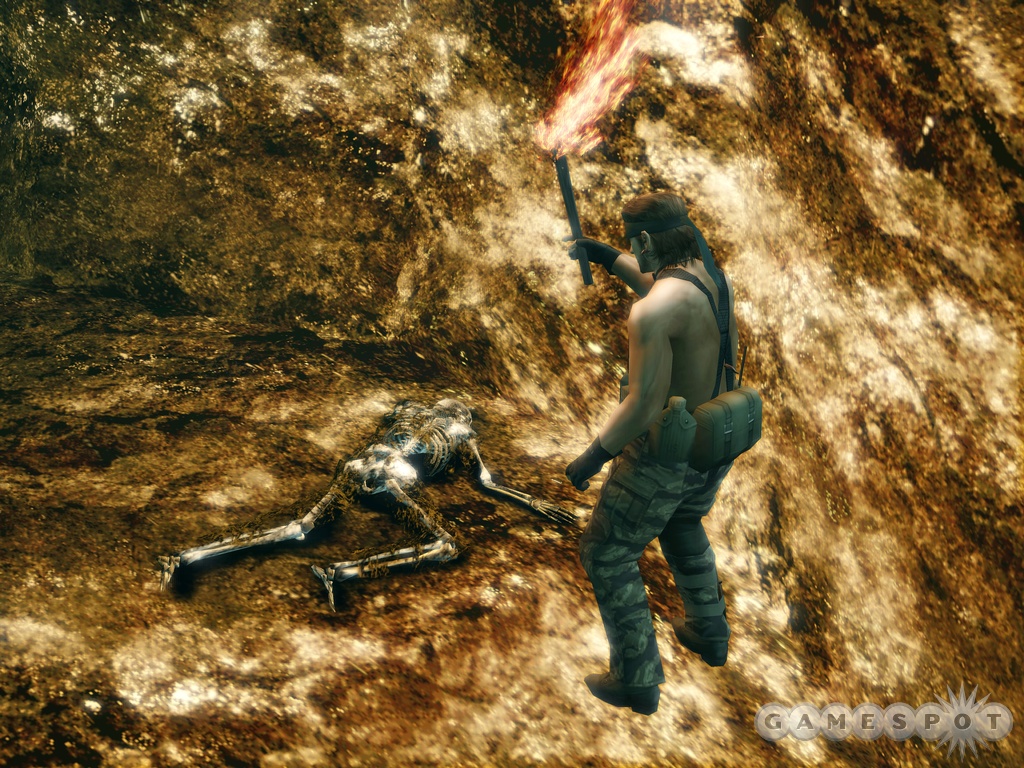
The game's visuals are quite impressive (especially those cutscenes), but they're also not quite as impressive as MGS2's visuals were for their time. That's partly because MGS2 was the first installment in the series on the PlayStation 2, but also partly because that game maintained a silky-smooth frame rate throughout, whereas this one does not. Granted, MGS3's environments are much more complex, filled with dense foliage, rustling leaves, little scurrying animals, and so on, but all this comes at the expense of a little graphical polish.
The audio in MGS3 is as impressive as you'd expect, especially the ambient sound and the music by composer Harry Gregson-Williams. The voice acting is a little forced, but it's exactly in tune with MGS3's predecessors. Of course, it's great to hear David Hayter reprise his role as Snake (or whoever he is), since his ham-fisted delivery sets the tone for a game that's way, way, way over the top.
We're told to expect this game to be the longest in the series yet, and judging by the sheer amount of story detail we've indulged in--not including all the purely optional conversations that can be had over Snake's radio--we believe it. The new elements of Metal Gear Solid 3's gameplay help put a twist on a familiar formula without really affecting that one-and-only MGS feel.
As for the story, we're certainly intrigued thus far, especially by some of the oblique references to the more-obscure portions of Metal Gear Solid 2's storyline, such as the La Li Lu Le Lo and The Patriots and all that business. Other lines of dialogue, such as, "You're a ghost, Snake, in every sense of the word," seem like they're just overflowing with hidden meaning. After all, what exactly is Snake doing in the '60s? This has to be his father, Big Boss, right? Who knows? From the very first minutes of Metal Gear Solid 3, the game clearly establishes that anything is possible in its strange vision of the past.
We're certainly excited to continue playing Metal Gear Solid 3: Snake Eater, and look forward to bringing you our full review in time for the game's release. For now, please take a look at some exclusive new media from the finished version of the game.
Got a news tip or want to contact us directly? Email news@gamespot.com
Join the conversation